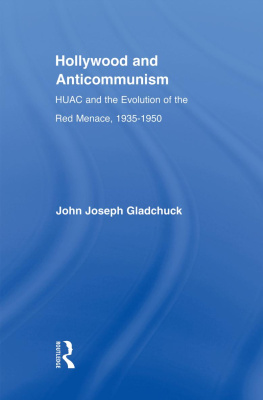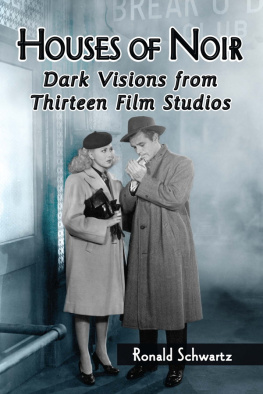Hollywood Enigma
HOLLYWOOD LEGENDS SERIES
CARL ROLLYSON, GENERAL EDITOR

Hollywood Enigma
DANA ANDREWS
CARL ROLLYSON

www.upress.state.ms.us
The University Press of Mississippi is a member of the Association of American University Presses.
Photo on page ii courtesy Dana Andrews Collection.
Copyright 2012 by University Press of Mississippi
All rights reserved
Manufactured in the United States of America
First printing 2012
Library of Congress Cataloging-in-Publication Data
Rollyson, Carl E. (Carl Edmund)
Hollywood enigma : Dana Andrews / Carl Rollyson.
p. cm. (Hollywood legends series)
Includes filmography.
Includes bibliographical references and index.
ISBN 978-1-60473-567-3 (cloth : alk. paper)
ISBN 978-1-61703-648-4 (ebook) 1. Andrews, Dana, 19091992.
2. Motion picture actors and actressesUnited StatesBiography. I.
Title.
PN2287.A615R86 2012
791.43028092dc23
[B] 2011052332
British Library Cataloging-in-Publication Data available
CONTENTS
ACKNOWLEDGMENTS
I DECIDED TO write this biography after I had a long telephone conversation with Susan Andrews about her father. At the time I knew relatively little about Dana Andrews, although I had watched Laura three or four times, entranced with the actor playing Mark McPherson. He reminded me of my father, a plain-clothes detective in 1940s Detroit. Like Mark, my father was a romantic who kept his emotions hidden behind a male mask. If I were to recreate my fathers biography, it would be as a film noir.
Susan described the substantial archive her father had amassed: a diary, letters, photographs, and other documents. I could already see that I would be able deal not only with a career I admired, but also with the whole man. And I would have the enthusiastic cooperation of his familynot just Susan and her sister, Katharine, and Katharines husband, Tim Smith, and Danas son Stephen, but also Danas grandchildren: Abigail, Ilena, and Matthew. I explained that I would need complete freedom to research and write the book, but that I would value their contributions and wanted them to review what I wrote before it was published. In the end, however, it was to be my book and subject to no ones censorship. Susan readily agreed, and so did her siblings. So I began. My biographers blood was up.
To say that the members of the Andrews family have been helpful is an inadequate acknowledgment of what they have contributed to this book. In the course of many interviews and hundreds of email exchanges, they provided candid and openhearted memories, often writing passages that have been integrated into the narrative of this biography. They also sent me DVD copies of the 16-millimeter film that Dana shot or had taken of him, his family, friends, and those he encountered on trips abroad.
That generosity is a tribute to Dana Andrews, who was about as open about himself as a human being can bewhile remaining, in certain fundamental respects, enigmatic. Of course he told the truth in his own way. We all do. And like so many self-invented figures, he constructed a life narrative that looked somewhat different from the way I have fashioned it. That is the difference, of course, between autobiography and biography. I have tried to let him have his say, even as I choose other angles from which to take his measure.
I have had the great good fortune to speak with Jeanne Andrews, the wife of Charles Andrews, Danas younger brother. She was able to take me back to the time when Dana first hit Hollywood. She also knew Danas father and the rest of the large Andrews family, and could share with me her memories of Texas in the 1930s and 1940s, when she and her husband returned to stay for twelve years before going back to California. Her son, Dana, named after his uncle, spoke with me about sailing and drinking with his fathers favorite brother, and in addition provided the precious resource that is Charless unfinished novel about Charles Forrest Andrews, the father who made such a deep impression on his progeny. A conversation with Dana and his sister Jeanne Marie also added considerably to my understanding of their Uncle Dana and his family.
Angela Fabry, the daughter of Danas brother David, devoted herself to answering my innumerable questions about what Dana and his brothers were like. She knew them all and has taken a special interest in the familys genealogy. Angela put me in touch with Aimee Abben, the daughter of Danas sister Mary. Aimee sent me photographs and other memorabilia full of invaluable details that helped to paint a picture of what it was like to grow up in Texas during Danas lifetime. My narrative would be much poorer if I had not had access to reminiscences contained in the material Aimee sent to me.
At a crucial moment, Sheila Simpson came through with valuable information about Janet Murray, Danas first wife, and about Janets family. Sheila also made many helpful suggestions, and I benefited from the dozen or more email exchanges I had with her.
Through David Andrews, a sixth cousin of Dana Andrews who had warm memories of meeting Dana at the Coconut Grove Playhouse in Miami, Florida, I received DVDs of Danas movies and help with genealogy and the history of Holmes County, where Charles Forrest Andrews was born. David is an important contributor to the Descendants of Thomas Andrews 1795 website at myfamily.com. There I made contact with Shawn Pearson and Rhett Farrior, who helped me understand the cultural and religious background of Charles Forrest Andrews.
I also have to thank Clyde Williams, who began work on a biography of Dana Andrews in the 1970s. He deposited his interviews in a Dana Andrews collection at Mississippi State University. Without Williamss work, I would not have had direct access to the reminiscences of Dana Andrews, Danas wife Mary, and his brothers David and John. Williams also did interviews with Susan and Stephen Andrews, who kindly supplied me with transcripts Williams made of their conversations.
Other librarians and archivists who have been especially helpful include the resourceful Ned Comstock at the Cinema Arts Library of the University of Southern California. At the University of California, Los Angeles, I received invaluable assistance from the indefatigable Julie Graham, Performing Arts, Special Collections; Mark Quigley, Manager, Research & Study Center, UCLA Film & Television Archive; and Jonathon Auxier, Curator, Warner Bros. Archive. I was also aided by Erin Chase, Curatorial Assistant, The Huntington Library; Mattie Abraham, Manuscripts Coordinator, Special Collections Department of Mississippi State University Libraries; Ashley Adair at the Dolph Briscoe Center for American History; and Mark Ekman of the Paley Center for Media in New York City. The staff at the Academy of Motion Pictures Arts and Sciences provided me with many important production and clipping files. And in so many ways my work would have been more difficult if I had not been able to rely on Valerie Yaros, historian of the Screen Actors Guild.
Thank you to Howard Prouty (hprouty@labridge.com) who at the last minute found for me that interview Dana did with Allan Eyles. Robert Lightermoet at Roberts Hard to Find Videos did indeed find the videos of Dana Andrewss movies I was seeking. Another helpful supplier was lovingtheclassics.com. Similarly, Jerry Haendiges (jerry@otrsite.com) was able to send me on CD those two Hollywood Fights Back broadcasts. Old Time Radio (otracat.com) sent me a marvelous CD that included the complete run of
Next page










